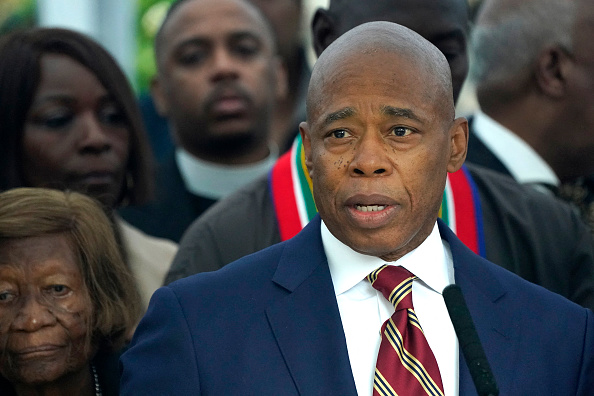To print this article, all you need is to be registered or login on Mondaq.com.
Highlights
- New York state has enacted changes in housing laws that will
have a significant impact on the development and operation of
multifamily housing in New York City and the state, and will also
ameliorate the effects of several provisions in the 2019 Housing
Security and Tenant Protection Act. - This Holland & Knight alert summarizes the impact of the
changes in the laws.
New York state has enacted changes in the housing laws that will
have a significant impact on the development and operation of
multifamily housing in New York City and the state, and will also
ameliorate the effects of several provisions in the 2019 Housing
Security and Tenant Protection Act (HSTPA).
This Holland & Knight alert summarizes the impact of the
changes in the laws. A future alert will contain a detailed
discussion of the new 485-x program that replaces the former 421-a
program, as well as the new exemption program for the conversion of
office buildings to residences. In addition, Holland & Knight
will host a webinar in May 2024 to examine the laws and provide
practical advice to the industry.
Rent Regulated Units
The following changes were made to the Emergency Tenant
Protection Act and the Rent Stabilization Law, which will impact
the rents paid on rent stabilized apartments for Individual
Apartment Improvements Increases (IAIs).
IAIs enable landlords to recover the costs of restoring,
renovating and upgrading individual apartments via permitted rent
increases set by applicable amortization schedules.
Under the HSTPA, rent increases for IAIs were 1) limited to
$15,000 2) part of the apartment’s rent only until the landlord
recovered the cost, and 3) to be removed from the rent after 30
years. However, the cost of upgrading an apartment that has been
occupied for an extended period of time greatly exceeds the $15,000
cap and, more generally, the $15,000 cap and the amortization
schedules imposed by the HSTPA (1/168 of the permitted cost in
buildings with 35 or fewer apartments and 1/180 of the permitted
cost in buildings with more than 35 apartments in both instances
spread over 15 years) did not properly account for construction and
renovation costs in New York City. These realities have led to a
glut of vacant rent stabilized apartments that are economically
infeasible for owners to rent. Accordingly, the following changes
were made:
- Rent increases under IAIs are again permanent (reversing the
2019 change) and are limited to vacant apartments. - The new cap for all units is $30,000, and amortization
schedules remain the same, except as below. - The cap may go to $50,000 under two scenarios: 1) after 25
years of prior occupancy, or 2) for units that were registered as
vacant in 2022, 2023 and 2024 only, regardless of prior tenancy
length. - For IAIs at $50,000, the amortization has been adjusted to
1/156 for buildings of more than 35 units and 1/144 for buildings
of 35 units or less. - This provision goes into effect in six months.
- The landlord must submit to the Division of Housing and
Community Renewal (DHCR) evidence that the work was done and pay a
fee of 1 percent of the IAI.
Tenant Protections (i.e., Good Cause Eviction)
Probably the most contentious issue in the housing package is
Good Cause Eviction (GCE), also referred to as rent control for
currently unregulated (i.e., market rate) apartments. GCE has been
the subject of much press attention and real estate and legal
industry discussion, along with numerous articles in the years
since its introduction. The Real Property Law and the Real Property
Actions and Proceedings Law have now been amended to include a form
of GCE that has been modified in many respects from its
much-discussed and vigorously debated prior version. GCE is now
applicable to many unregulated apartments in New York City and can
be applicable to other municipalities in New York state that elect
to participate. The premise of GCE is that landlords will be
prevented from attempting to evict tenants without a “good
cause” specified in the statute.
- Duration: The GCE provisions will expire in 2034.
- Rent Limitations:
- There is a “rebuttable presumption” that a rent
increase of 5 percent plus the Consumer Price Index (CPI), or 10
percent of the existing rent, whichever is less (i.e., the Local
Rent Standard), is “unreasonable” and thus
impermissible. - Rent increases equal to or below the Local Rent Standard are,
by definition, not “unreasonable” and are immune from
challenge. - If challenged by a tenant in court, an owner may overcome the
rebuttable presumption that a rent increase above the Local Rent
Standard is “unreasonable.” In considering whether an
apartment’s rent can exceed the Local Rent Standard, courts
“may consider all relevant facts,” including, without
limitation:
- The landlord’s costs for fuel and other utilities,
insurance and maintenance - Property tax expenses and any recent increases thereto,
and - Whether the landlord seeks in good faith to raise the rent upon
a renewal lease to reflect completed significant repairs to the
housing accommodation, or to any other part of the building or real
property in which the housing accommodation is located (with
limitations and exceptions)
- The landlord’s costs for fuel and other utilities,
- Lease renewal offers are required except under the following
circumstances:
- When an owner:
- Seeks to recover a housing accommodation for personal use
- Seeks to remove the housing accommodation/property from the
rental market - Plans to demolish the building
- When a tenant:
- Fails to pay rent due and owing (subject to exceptions for
“unreasonable” rent increases as discussed above) - Violates a substantial obligation of its tenancy
- Fails to execute a reasonable renewal lease
- Commits a nuisance or causes substantial damage to the housing
accommodation or real property - Uses the housing accommodation for an illegal purpose
- Is occupying the housing accommodation in violation of law
- Refuses access to the owner for certain specified reasons
- Fails to pay rent due and owing (subject to exceptions for
- The following types of units are exempt:
- Rent-stabilized or rent-controlled units
- Affordable, income-restricted units
- Condo and co-op units
- New construction for which a temporary or permanent certificate
of occupancy is hereafter issued or was issued on or after Jan. 1,
2009; the exemption lasts for 30 years following issuance of such
certificate - Units in buildings of 10 units or less if owner occupied
- Units that are part of small owner portfolios of 10 units or
less - Subleased units
- Units occupied solely as incidents of employment
- Seasonal use dwelling units
- Housing accommodations in hospitals and assisted living
facilities - Manufactured homes in manufactured home parks
- Hotel/transient rooms
- School dormitories
- Housing accommodations within and used by religious
institutions - “Luxury” rent exemption for units renting above 245
percent of the fair market rent set by the U.S. Department of
Housing and Urban Development, which presently would be the
following monthly rents:
- When an owner:
- There is a “rebuttable presumption” that a rent
|
Studio
|
$5,846
|
|
1 Bedroom
|
$6,005
|
|
2 Bedroom
|
$6,742
|
|
3+ Bedroom
|
$8,413
|
Additional requirements include:
- The definition of tenant is limited to the definition under
preexisting law and explicitly excludes squatters and non-paying
roommates, among others. - The definition of rent does not include amenities and other
charges besides rent such as storage and parking charges. - The legislation is ambiguous concerning whether the rent
limitations 1) apply only during a tenancy and the rent can be
“marked to market” upon a vacancy, or 2) apply across
tenancies notwithstanding vacancies. Litigation of this issue may
occur in the very near future. - Litigation is also likely over whether landlords fall under the
poorly drafted “small landlord” (10 units owned or less)
exemption. - The legislation creates additional notice requirements
applicable to all residential leases, requiring landlords to
disclose:
- Whether the housing accommodation at issue is subject to GCE
and if not, the basis for the exemption, and - If the housing accommodation is subject to GCE, landlords must
send notices to tenants justifying any rent increase above the
Local Rent Standard or why the landlord is electing not to renew
the lease.
- Whether the housing accommodation at issue is subject to GCE
The legislation also requires landlords to disclose the
aforesaid information in certain statutory predicate notices, as
well as in New York Housing Court petitions.
Housing Production
The New York state legislature also enacted two new tax
exemption programs: 1) the Affordable Neighborhoods for New Yorkers
Program (485-x program) to replace the expired Affordable New York
Housing Program, and 2) a new program to assist conversions of
office buildings to residences. Additionally, the state
legislature’s elimination of housing density limitations will
permit the construction of larger residential buildings. The
following is a brief summary of the major requirements of these
programs. Holland & Knight will publish a more detailed alert
that will provide further details on these new programs.
485-x Program Rental Requirements
|
Building Size
|
Affordability Share
|
Area Median Income (AMI) Level
|
|
6-10 units outside Manhattan for lots below 12,500 square feet
|
20 percent
|
80 percent
|
|
6-10 units outside Manhattan for lots below 12,500 square feet
|
50 percent rent stabilized or 20 percent affordable
|
80 percent
|
|
11-99 units
|
20 percent
|
80 percent
|
|
100+ units
|
25 percent
|
80 percent
|
|
150+ units in wage Zone A / Zone B
|
25 percent
|
60 percent
|
Additional requirements include:
- No more than three bands, and no band may exceed 100 percent
AMI - Requires permanent affordability
- Market rate units are not stabilized
- A homeownership tax benefit is also available for 100 percent
affordable projects where the average assessed value per square
foot is no more than $89
Tax benefit terms are also determined by building size and type,
and location within a wage zone. Mini tax is paid during
construction and then refunded after, consistent with 421a-16. An
exception is that buildings with more than 150 units in Zone A and
Zone B do not pay the mini tax during construction.
485-x Construction Wage Standard
Projects with more than 150 units in certain geographic areas
must comply with a trade-based wage.
- Zone A: All workers within a trade must be
paid the lesser of $72.45/hour, or 65 percent of prevailing
rate. - Zone B: All workers within a trade must be
paid the lesser of $63/hour, or 60 percent of prevailing rate. - These rates increase by 2.5 percent annually.
|
Zone A: Manhattan below 96th Street
|
Zone B: Neighborhood Tabulation Areas
|
- A citywide elevated minimum wage/benefit is required for
projects with more than 100 units. - An exemption is available for projects using a project labor
agreement (PLA) or collective bargaining agreement (CBA). - Enforcement will be done by the city comptroller via a
complaint-based regime. - The comptroller could revoke benefits for multiple uncured
violations of the construction wage provisions.
Office to Residential Conversions
- Conversion projects must deliver 25 percent of units at a
weighted average of 80 percent AMI, with a band at 5 percent of
units at 40 percent AMI. - The tax incentive is structured to provide a 90 percent
discount off the effective residential tax rate with the following
benefit durations:
- A 35-year benefit is available if filed AND receive a permit by
June 30, 2026 - A 30-year benefit is available if filed AND receive a permit by
June 30, 2028 - A 25-year benefit is available if filed AND receive a permit by
June 30, 2031
- A 35-year benefit is available if filed AND receive a permit by
Lifting of Housing Density Limitations
Eliminates the 12 Floor Area Ratio (FAR) cap (i.e., the ratio of
the building’s square footage to the size of the lot on which
it is built) on new residential developments meeting certain
requirements, including, among others:
- Certain minimum percentages of new units are subject to
permanent affordability requirements - Such new buildings cannot be located within a historic district
or on the same zoning lot as a building subject to the Loft
Law - Compliance with relocation/compensation requirements for
existing tenants in buildings to be demolished for construction of
new over-12 FAR buildings - Compliance with “Certificate of No Harassment”
requirements under existing city law
The content of this article is intended to provide a general
guide to the subject matter. Specialist advice should be sought
about your specific circumstances.
POPULAR ARTICLES ON: Real Estate and Construction from United States
#Yorks #Housing #Laws #Landlord #Tenant #Leases











